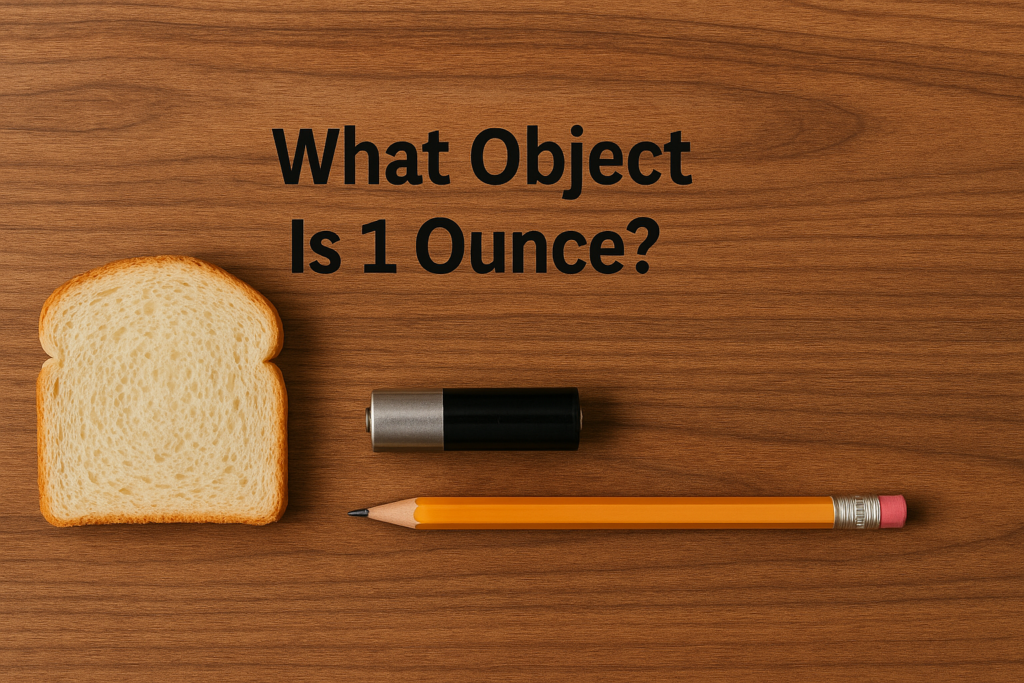
When it comes to understanding weight, 1 ounce may seem small—but knowing exactly what object is 1 ounce can be surprisingly useful. From cooking to shipping to everyday life, understanding how much an ounce weighs helps in making more informed choices. This guide gives you clear comparisons, examples, and simple ways to visualize the weight of 1 ounce, all based on real-life, everyday objects.
Understanding the Ounce: What Does 1 Ounce Weigh?
The ounce is a unit of weight used in the U.S. customary and British imperial systems.
- 1 ounce (oz) = 28.35 grams
- It’s 1/16 of a pound
- In volume (fluid ounces), it differs, but this article focuses on weight
While small in scale, knowing what equals 1 ounce helps with portion control, postage, shopping, and measuring items without a scale.
Common Objects That Weigh About 1 Ounce
Here are several familiar, everyday items that weigh approximately 1 ounce:
1. A Slice of Bread
A single slice of sandwich bread (especially white or wheat) typically weighs around 1 ounce. It’s an easy reference for those involved in meal prepping or calorie counting.
2. Standard AA Battery
A standard AA battery weighs about 0.9 to 1 ounce, making it a great physical reference to understand the weight in your hand.
3. Pencil or Pen
A regular wooden pencil or standard ink pen is close to 1 ounce. This is especially helpful for visual learners.
4. Compact Makeup Item (Lip Balm)
A tube of lip balm, like a ChapStick, is just about 1 ounce. This makes it a quick go-to for travelers needing to stay within airline liquid limits.
5. Small Matchbox or Packet of Seeds
A small box of matches or a typical garden seed packet weighs close to 1 ounce, depending on contents.
6. A Single Slice of Deli Meat
One thin slice of deli turkey or ham is typically around 1 ounce, which helps when estimating food portions.
Why Knowing What 1 Ounce Feels Like Matters
Cooking and Baking
Recipes often call for ounces in measuring ingredients—especially meat, cheese, or dry goods. Knowing what object is 1 ounce helps with portion control and recipe accuracy.
Shipping and Mailing
Postage for letters and packages is often calculated in ounces. For instance, a standard first-class USPS letter can weigh up to 1 ounce before an extra stamp is needed (source).
Health and Nutrition
1 ounce is a standard serving size for many foods, like nuts or cheese. Understanding this visually supports better dietary choices.
Travel Packing
Airline regulations, especially for carry-ons, often use ounces to define liquid limits (e.g., 3.4 oz). Recognizing 1 ounce helps avoid overpacking.
How to Measure 1 Ounce Without a Scale
If you don’t have a kitchen or postal scale, here are a few easy tricks:
- Use your hand: A handful of nuts is often about 1 ounce.
- Use known items: As listed earlier, a slice of bread or an AA battery is a helpful comparison.
- Coins: A U.S. quarter weighs 0.2 ounces. Five quarters weigh 1 ounce.
Comparing 1 Ounce to Other Units
| Unit | Equivalent to 1 Ounce |
|---|---|
| Grams | 28.35 g |
| Pounds | 1/16 lb |
| Kilograms | 0.0283 kg |
| Quarters (coin) | 5 coins |
This comparison puts the ounce in perspective with both imperial and metric systems.
Conclusion
So, what object is 1 ounce? Think of a slice of bread, an AA battery, or a wooden pencil—each offers a tangible way to estimate this small but significant weight. Whether you’re cooking, mailing, or simply curious, understanding 1 ounce through real-life examples makes your day-to-day tasks easier and more precise.



